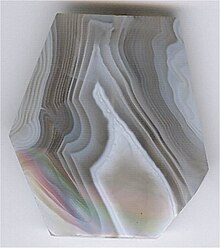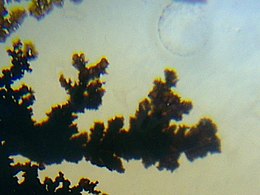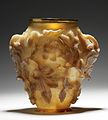Agate
| Agate | |
|---|---|
 19.6 kg (43 lb) specimen of "Crazy Lace" agate from Chihuahua, Mexico next to a tennis ball; 38.2 cm (15.0 in) wide | |
| General | |
| Category | Chalcedonyvariety |
| Formula (repeating unit) | SiO2(silicon dioxide) |
| Crystal system | Trigonalormonoclinic |
| Identification | |
| Color | banded |
| Crystal habit | Cryptocrystallinesilica |
| Cleavage | None |
| Fracture | Conchoidal,with very sharp edges |
| Mohs scalehardness | 6.5–7 |
| Luster | Waxy |
| Streak | White |
| Diaphaneity | Translucent |
| Specific gravity | 2.58–2.64 |
| Refractive index | 1.530–1.540 |
| Birefringence | up to +0.004 (B-G) |
| Pleochroism | Absent |
Agate(/ˈæɡɪt/AG-it) is the banded variety ofchalcedony,[1]which comes in a wide variety of colors. Agates are primarily formed withinvolcanicandmetamorphic rocks.The ornamental use of agate was common inAncient Greece,in assortedjewelryand in theseal stonesof Greek warriors,[2]while bead necklaces with pierced and polished agate date back to the3rd millennium BCEin theIndus Valley civilisation.
Etymology[edit]
The stone was given its name byTheophrastus,aGreekphilosopherandnaturalist,who discovered the stone along the shore line of theDirillo Riveror Achates (Ancient Greek:Ἀχάτης) inSicily,[3]sometime between the 4th and 3rd centuries BCE.[4]
Formation and properties[edit]


Agate minerals have the tendency to form on or within pre-existing rocks, creating difficulties in accurately determining their time of formation.[5]Their host rocks have been dated to have formed as early as theArcheanEon. Agates are most commonly found asnoduleswithin the cavities ofvolcanic rocks.These cavities are formed from the gases trapped within the liquid volcanic material formingvesicles.[6]Cavities are then filled in with silica-rich fluids from the volcanic[6]material, layers are deposited on the walls of the cavity slowly working their way inwards.[7]The first layer deposited on the cavity walls is commonly known as the priming layer.[8]Variations in the character of the solution or in the conditions of deposition may cause a corresponding variation in the successive layers. These variations in layers result in bands ofchalcedony,often alternating with layers of crystallinequartzforming banded agate.[6]Hollow agates can also form due to the deposition of liquid-rich silica not penetrating deep enough to fill the cavity completely.[9]Agate will form crystals within the reduced cavity, and the apex of each crystal may point towards the center of the cavity.
The priming layer is often dark green, but can be modified byiron oxideresulting in a rust like appearance.[8]Agate is very durable, and is often found detached from its host matrix, which has eroded away. Once removed, the outer surface is usually pitted and rough from filling the cavity of its former matrix. Agates have also been found insedimentary rocks,[6]normally inlimestoneordolomite;these sedimentary rocks acquire cavities often from decomposed branches or other buried organic material. If silica-rich fluids are able to penetrate into these cavities agates can be formed.[6]
Types[edit]
Lace agateis a variety that exhibits alace-like pattern with forms such as eyes, swirls, bands or zigzags.Blue lace agateis found in Africa and is especially hard.[10]Crazy lace agate,typically found in Mexico, is often brightly colored with a complex pattern, demonstrating randomized distribution of contour lines and circular droplets, scattered throughout the rock. The stone is typically coloured red and white but is also seen to exhibit yellow and grey combinations as well.[11]
Moss agate,as the name suggests, exhibits a moss-like pattern and is of a greenish colour. The coloration is not created by any vegetative growth, but rather through the mixture of chalcedony and oxidized iron hornblende.Dendritic agatealso displays vegetative features, including fern-like patterns formed due to the presence of manganese and iron oxides.[12]
Turritella agate(Elimia tenera)is formed from the shells of fossilized freshwaterTurritellagastropodswith elongated spiral shells. Similarly,coral,petrified wood,porous rocks and other organic remains can also form agate.[13]
Coldwater agates,such as the Lake Michigan cloud agate, did not form under volcanic processes, but instead formed within thelimestoneand dolomite strata of marine origin. Like volcanic-origin agates, Coldwater agates formed from silica gels that lined pockets and seams within the bedrock. These agates are typically less colorful, with banded lines of grey and white chalcedony.[14]
Greek agateis a name given to pale white to tan colored agate found in the former Greek colony ofSicilyas early as 400 BCE. The Greeks used it for making jewelry and beads.
Brazilian agateis found as sizable geodes of layered nodules. These occur in brownish tones inter-layered with white and gray. It is often dyed in various colors for ornamental purposes.
Polyhedroid agateforms in a flat-sided shape similar to apolyhedron.When sliced, it often shows a characteristic layering of concentricpolygons.It has been suggested that growth is not crystallographically controlled but is due to the filling-in of spaces between pre-existing crystals which have since dissolved.
Iris agateis a finely-banded and usually colorless agate, that when thinly sliced, exhibits spectral decomposition of white light into its constituent colors, requiring 400 to up to 30,000 bands per inch.[15]
Other forms of agate includeHolley blue agate(also spelled "Holly blue agate" ), a rare dark blue ribbon agate found only nearHolley, Oregon;Lake Superior agate;Carnelian agate(has reddish hues);Botswana agate;plume agate;condor agate;tube agatecontaining visible flow channels or pinhole-sized "tubes";fortification agatewith contrasting concentric banding reminiscent of defensive ditches and walls around ancient forts;Binghamite,a variety found only on the Cuyuna iron range (near Crosby) in Crow Wing County, Minnesota;fire agateshowing an iridescent, internal flash or "fire", the result of a layer of clear agate over a layer of hydrothermally deposited hematite;Patuxent River stone,a red and yellow form of agate only found inMaryland;andenhydro agate,which contains tiny inclusions of water, sometimes with air bubbles.
-
Agatized coral
-
Dendritic agate
-
"Turritella agate" (Elimia tenera)
-
Crazy lace agate
Uses[edit]

Agate is one of the most common materials used in the art ofhardstone carving,and has been recovered at a number of ancient sites, indicating its widespread use in the ancient world; for example, archaeological recovery at theKnossossite onCreteillustrates its role inBronze AgeMinoanculture.[16]It has also been used for centuries forleather burnishingtools.
The decorative arts use it to make ornaments such aspins,broochesor other types ofjewellery,paper knives,inkstands,marblesandseals.Agate is also still used today for decorative displays, cabochons, beads, carvings andIntarsiaart as well as face-polished and tumble-polished specimens of varying size and origin.Idar-Obersteinwas one of the centers which made use of agate on an industrial scale. Where in the beginning locally found agates were used to make all types of objects for the European market, this became a globalized business around the turn of the 20th century: Idar-Oberstein imported large quantities of agate from Brazil, as ship's ballast. Making use of a variety of proprietary chemical processes, they produced colored beads that were sold around the globe.[17]Agates have long been used in arts and crafts. The sanctuary of a Presbyterian church inYachats, Oregon,has six windows with panes made of agates collected from the local beaches.[18]
Industrial uses of agate exploit its hardness, ability to retain a highly polished surface finish and resistance to chemical attack. It has traditionally been used to make knife-edge bearings forlaboratory balancesand precision pendulums, and sometimes to makemortars and pestlesto crush and mix chemicals.
-
A 6.8 kg (15 lb) barrel full of tumble-polished agate andjasper
-
Gold Roman signet ring with portrait of emperorCommodusin niccolo agate, 180-200 CE, found in Tongeren,Gallo-Roman Museum (Tongeren)
-
The "Rubens Vase"(Byzantine Empire). Carved in high relief from a single piece of agate, most likely created in an imperial workshop for a Byzantine emperor.
-
Victorian banded agate earrings
-
Maryland Agate - Cut and illuminated to show internal structures
Health impact[edit]
Respiratory diseases such assilicosis,and a higherincidenceoftuberculosisamong workers involved in the agate industry, have been studied inIndiaand China.[19][20][21]
See also[edit]
- Amber
- Amethyst
- Aqeeq
- Aquamarine
- Citrine
- Diamond
- Emerald
- Garnet
- Geode
- Kyanite
- Labradorite
- List of minerals– List of minerals with Wikipedia articles
- Lithophysa
- Moonstone
- Opal
- Peridot
- Rose Quartz
- Swiss Blue Topaz
- Thunderegg
- Tiger's Eye
- Topaz
- Tourmaline
- Turquoise
Citations[edit]
- ^Wang, Yifeng; Merino, Enrique (1990-06-01). "Self-organizational origin of agates: Banding, fiber twisting, composition, and dynamic crystallization model".Geochimica et Cosmochimica Acta.54(6): 1627–1638.Bibcode:1990GeCoA..54.1627W.doi:10.1016/0016-7037(90)90396-3.ISSN0016-7037.
- ^"Masterpiece of Greek Art Found in the Griffin Warrior Tomb".Smithsonian.Smithsonian Institution.7 November 2017.
- ^"Agate Creek Agate".Archived fromthe originalon 16 July 2007.Retrieved2007-07-01.
- ^"Achates".Archivedfrom the original on 26 August 2023.Retrieved19 September2014.
- ^"Agate: Mineral information, data and localities".mindat.org.Archivedfrom the original on 2020-02-15.Retrieved2020-02-11.
- ^abcdeT, Moxon (2006)."Agate and chalcedony from igneous and sedimentary hosts aged from 13 to 3480 Ma: a cathodoluminescence study".Mineralogical Magazine.70(5): 485–498.Bibcode:2006MinM...70..485M.doi:10.1180/0026461067050347.S2CID54607138.Archivedfrom the original on March 13, 2022.RetrievedOctober 1,2006.
- ^Walger, Eckart; Mattheß, Georg; von Seckendorff, Volker; Liebau, Friedrich (August 2009)."The formation of agate structures: models for silica transport, agate layer accretion, and for flow patterns and flow regimes in infiltration channels".ingentaconnect.Archivedfrom the original on June 4, 2018.RetrievedMarch 3,2020.
- ^ab"Metaphysical Properties of Yellow Skin Agate - Stone Treasures".Stone Treasures by the Lake.24 March 2019.Archivedfrom the original on 2020-02-26.Retrieved2020-02-27.
- ^"Agate chalcedony: The mineral Agate information and pictures".minerals.net.Archivedfrom the original on 2020-03-16.Retrieved2020-02-27.
- ^Simmons, Robert; Ahsian, Naisha (2007).The Book of Stones: Who They Are and What They Teach.North Atlantic Books.ISBN978-1-55643-668-0.Archivedfrom the original on 2023-08-26.Retrieved2020-10-29.
- ^Atkinson, Bill; Ackerman, Diane (2004).Within the Stone: Photography.BrownTrout Publishers.ISBN978-0-7631-8189-5.Archivedfrom the original on 2023-08-26.Retrieved2020-10-29.
- ^Schumann, Walter (2009).Gemstones of the World.Sterling Publishing Company, Inc.ISBN978-1-4027-6829-3.Archivedfrom the original on 2023-08-26.Retrieved2020-10-29.
- ^Grant, Ember (2016-06-08).The Second Book of Crystal Spells: More Magical Uses for Stones, Crystals, Minerals... and Even Salt.Llewellyn Worldwide.ISBN978-0-7387-4844-3.Archivedfrom the original on 2023-08-26.Retrieved2020-10-29.
- ^Garvin, Paul (2010-09-13).Iowa's Minerals: Their Occurrence, Origins, Industries, and Lore.University of Iowa Press.ISBN978-1-60938-014-4.Archivedfrom the original on 2023-08-26.Retrieved2020-10-29.
- ^"Iris Agate".Archivedfrom the original on 2022-07-01.Retrieved2022-05-27.
- ^C. Michael Hogan. 2007.Knossos fieldnotes,Modern AntiquarianArchived2018-07-11 at theWayback Machine
- ^"Background Article on Idar Oberstein".Archivedfrom the original on 2008-12-23.Retrieved2008-11-27.
- ^"Agate Windows - Community Presbyterian Church".Archived fromthe originalon 1 March 2012.Retrieved19 September2014.
- ^Chaudhury, Nayanjeet; Phatak, Ajay; Paliwal, Rajiv (January 2012)."Co-morbidities among silicotics at Shakarpur: A follow up study".Lung India.29(1): 6–10.doi:10.4103/0970-2113.92348.PMC3276038.PMID22345906.
- ^Jiang, CQ; Xiao, LW; Lam, TH; Xie, NW; Zhu, CQ (July 2001). "Accelerated silicosis in workers exposed to agate dust in Guangzhou, China".American Journal of Industrial Medicine.40(1): 87–91.doi:10.1002/ajim.1074.PMID11439400.
- ^Tiwari, RR; Narain, R; Sharma, YK; Kumar, S (September 2010)."Comparison of respiratory morbidity between present and ex-workers of quartz crushing units: Healthy workers' effect".Indian Journal of Occupational and Environmental Medicine.14(3): 87–90.doi:10.4103/0019-5278.75695.PMC3062020.PMID21461160.
General and cited references[edit]
- Cross, Brad L. and Zeitner, June Culp.Geodes: Nature's Treasures.Bardwin Park, Calif.: Gem Guides Book Co. 2005.
- Hart, Gilbert"The Nomenclature of Silica",American Mineralogist,Volume 12, pages 383–395, 1927
- International Colored Gemstone Association,"Agate: banded beauty"
- "Agate",Mindat.org, Hudson Institute of Mineralogy
- Moxon, Terry.Agate: Microstructure and Possible Origin.Doncaster, S. Yorks, UK: Terra Publications, 1996.
- Pabian, Roger, et al.Agates: Treasures of the Earth.Buffalo, New York: Firefly Books, 2006.
- Schumann, Walter.Gemstones of the World.3rd edition. New York: Sterling, 2006.
External links[edit]
- "Agates",School of Natural Resources, University of Nebraska-Lincoln (retrieved 27 December 2014).









